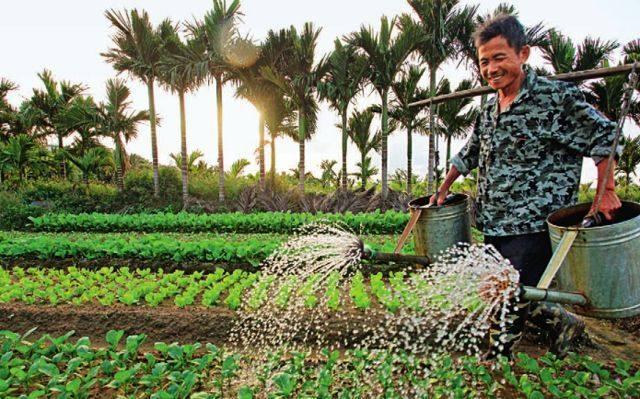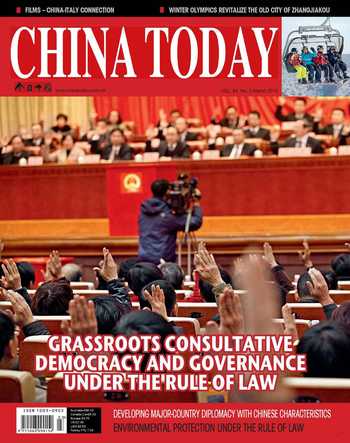Better Environment,Better Life in the Countryside
By staff reporter LU RUCAI

FOR the past 12 years, the most important annual policy document issued by Chinas central authorities has dealt with agriculture, farmers and rural areas. In 2015, the Central Rural Work Conference for the first time put equal emphasis on building a “physical new countryside”and a “people-oriented new countryside,” with the aim of improving living environments and quality of life.
Food Security
In 2014 Chinas grain output reached 607.099 million tons, an increase of 0.9 percent, marking 11 consecutive years of rising grain production.
Food security is a major concern of the Chinese government. The conference put forward a national food security strategy which emphasizes domestic supply and moderate imports, ensuring production capacity and endorsing science and technology. The conference reached the consensus that only by basically ensuring self-sufficiency in grain supply can China gain food security and propel economic and social development.
According to Li Guoxiang, a rural economics researcher at the Chinese Academy of Social Sciences, although Chinas grain production is increasing, its resource consumption is unsustainable. China uses 4.1 times more fertilizer per hectare than the world average, according to his research. This has reduced soil fertility and degraded 40 percent of the countrys arable land. Consequently, a change is imperative.
China is aware of its agricultural challenges. Along with the changed conditions at home and abroad as well as the deep-seated problems of long-term extensive operation, Chinas agricultural development is facing unprecedented challenges. This is why the conference raised “building resource-conserving and environmentally-friendly agriculture” as one of its important future tasks for the future.
Orderly Transfer of Land Management Rights
In 2013, some 270 million rural residents migrated to urban areas to seek employment, accounting for 45 percent of the total rural labor force. Among them, 170 million spent more than six months in cities, accounting for one third of the countrys total rural labor force. “Who will do farm work?” has hence become an unavoidable problem in trying to resolve Chinas grain supply. Therefore, the conference proposed actively developing diversified and largescale farming, putting orderly transfer of land management rights under guidance and regulation, and developing new management entities in agricultural production.
Explorations of large-scale farming began long ago. In 2001, the central government prepared for the transfer of land-use rights. The Law on Contracting of Rural Land, promulgated in 2003, explicitly stated the rights of land transfer, and in 2014, China published a policy document on orderly transfer of rural land-use rights. Minister of Agriculture Han Changfu said that with industrialization and urbanization, farmers will gradually move to cities and the area of land each farmer cultivates will grow continuously. Advanced agricultural technology and equipment will modernize the countryside.
A growing numbers of farmers do not work 0n their contracted land. Therefore, it is time to separate contracting rights from management rights. The separation of collective land ownership, contracting rights and management rights is an important foundation for rural administration.
Progress has already been made in large-scale farming based on transfer of land-management rights. In 2014, the Ministry of Agriculture released its monitoring and evaluation report on national modern agricultural demonstration zones. According to the report, China has made significant headway in 153 national modern agricultural demonstration zones. Their total area of arable land reached 16.4 million hectares and grain output reached 122.5 billion tons, and the added value of farming, livestock, and fisheries amounted to RMB 774.8 billion. These lands, accounting for 13.1 percent of Chinas cultivated land, produced 20.8 percent of the countrys total grain output. Grain production per hectare and per capita net income were 30 percent higher than the national average. Fourteen of these areas have basically realized agricultural modernization.
Han Changfu stated that, by the end of June 2014, 2.58 million hectares of contracted land were transferred to companies, and this number increases every year. This practice is a double-edged sword. While it introduces advanced techniques and business models, it also occupies the employment space of rural people and intensifies non-grain cultivation and de-agriculturization. Thus to guide and supervise the orderly transfer of land-use rights, the most important principle is to make grain production and agriculture the mainstay, curb nongrain cultivation trends and prohibit deagriculturization.
Improved Quality of Life
Although agriculture plays an important role in China, farmers have long suffered low incomes and social status. In 2013, the per capita net income of farmers was RMB 8,896. Although farmers incomes have grown faster than those of urban residents for four consecutive years, the income gap between urban and rural residents continues to widen.
Under such circumstances, the conference proposed enriching farmers by providing them with training and support to make agriculture profitable.
According to Cheng Guoqiang, a researcher at the Development Research Center of the State Council, the “physical new countryside” refers to the improve- ment of living environments, including roads, drinking water, electricity and housing conditions. The “peopleoriented new countryside” refers to establishing fundamental public services, preserving rural culture and the natural environment. This reflects the central authorities higher requirements for building the new countryside.
Currently, the rural cooperative medical system and endowment insurance are approaching full coverage. However, the proportions of contributions and reimbursements are still much lower than those of urban residents. Significant disparities exist between different regions due to uneven economic development. As a result, there is an urgent need for the government to improve rural public services as well as rehabilitate and protect rural ecological environments.
In addition, an agreement was reached in the conference to push forward urbanization in a down-to-earth manner. By 2020, China will provide houses for 100 million rural-to-urban migrants, rebuild run-down areas and“villages under the jurisdiction of cities” for 100 million more, and promote urbanization in central and western regions for another 100 million people. Through new-type urbanization and modernization, China will spare no effort to provide rural populations with better lives.

